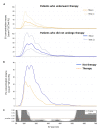The Role of Extracellular Vesicles in Ischemic Stroke Severity
- PMID: 36290393
- PMCID: PMC9598264
- DOI: 10.3390/biology11101489
The Role of Extracellular Vesicles in Ischemic Stroke Severity
Abstract
The possibility of characterizing the extracellular vesicles (EVs) based on parental cell surface markers and their content makes them a new attractive prognostic biomarker. Thus, our study aims to verify the role of EVs as relevant prognostic factors for acute and mid-term outcomes in ischemic stroke. Forty-seven patients with acute ischemic stroke were evaluated at admission (T0), immediately after recanalization treatment or after 2 h in non-treated patients (T1) and after one week (Tw) using the National Institutes of Health Stroke Scale (NIHSS), and after 3 months using the Modified Rankin Scale (mRS). Total count and characterization of EVs were assessed by Nanosight analysis and flow cytometry. The relationships between stroke outcomes and EV count were assessed through multivariable negative binomial regression models. We found that the amount of platelet-derived EVs at admission was positively associated with the severity of ischemic stroke at the onset as well as with the severity of mid-term outcome. Moreover, our study revealed that T-cell-derived EVs at admission were positively related to both early and mid-term ischemic stroke outcomes. Finally, T-cell-derived EVs at T1 were positively related to mid-term ischemic stroke outcome. The present study suggests that specific EV subtypes are associated with stroke severity and both short- and long-term outcomes. EVs could represent a valid tool to improve risk stratification in patients with ischemic stroke and post-recanalization treatment monitoring.
Keywords: T-cell-derived extracellular vesicles; extracellular vesicles; ischemic stroke; platelet-derived extracellular vesicles.
Conflict of interest statement
The authors declare no conflict of interest.
Figures


References
-
- World Health Organization The Top 10 Causes of Death. [(accessed on 26 April 2021)]. Available online: https://www.who.int/news-room/fact-sheets/detail/the-top-10-causes-of-death.

